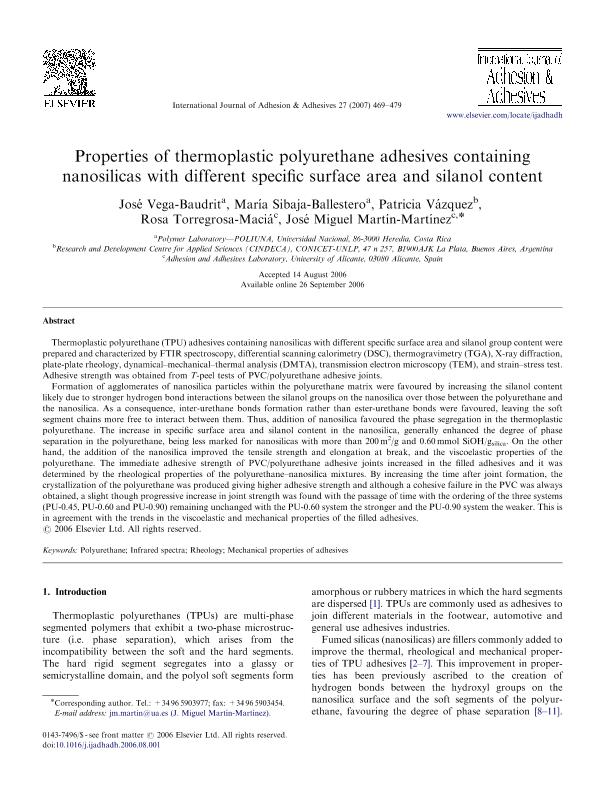Artículo
Properties of thermoplastic polyurethane adhesives containing nanosilicas with different specific surface area and silanol content
Vega Baudrit, José; Sibaja Ballester, María; Vazquez, Patricia Graciela ; Torregrosa Maciá, Rosa; Martín Martínez, José Miguel
; Torregrosa Maciá, Rosa; Martín Martínez, José Miguel
 ; Torregrosa Maciá, Rosa; Martín Martínez, José Miguel
; Torregrosa Maciá, Rosa; Martín Martínez, José Miguel
Fecha de publicación:
09/2007
Editorial:
Elsevier
Revista:
International Journal Of Adhesion And Adhesives
ISSN:
0143-7496
Idioma:
Inglés
Tipo de recurso:
Artículo publicado
Clasificación temática:
Resumen
Thermoplastic polyurethane (TPU) adhesives containing nanosilicas with different specific surface area and silanol group content were prepared and characterized by FTIR spectroscopy, differential scanning calorimetry (DSC), thermogravimetry (TGA), X-ray diffraction, plate-plate rheology, dynamical–mechanical–thermal analysis (DMTA), transmission electron microscopy (TEM), and strain–stress test.
Adhesive strength was obtained from T-peel tests of PVC/polyurethane adhesive joints. Formation of agglomerates of nanosilica particles within the polyurethane matrix were favoured by increasing the silanol content likely due to stronger hydrogen bond interactions between the silanol groups on the nanosilica over those between the polyurethane and the nanosilica. As a consequence, inter-urethane bonds formation rather than ester-urethane bonds were favoured, leaving the soft segment chains more free to interact between them. Thus, addition of nanosilica favoured the phase segregation in the thermoplastic polyurethane. The increase in specific surface area and silanol content in the nanosilica, generally enhanced the degree of phase separation in the polyurethane, being less marked for nanosilicas with more than 200 m2/g and 0.60 mmol SiOH/gsilica. On the other
hand, the addition of the nanosilica improved the tensile strength and elongation at break, and the viscoelastic properties of the polyurethane. The immediate adhesive strength of PVC/polyurethane adhesive joints increased in the filled adhesives and it was determined by the rheological properties of the polyurethane–nanosilica mixtures. By increasing the time after joint formation, the crystallization of the polyurethane was produced giving higher adhesive strength and although a cohesive failure in the PVC was always obtained, a slight though progressive increase in joint strength was found with the passage of time with the ordering of the three systems (PU-0.45, PU-0.60 and PU-0.90) remaining unchanged with the PU-0.60 system the stronger and the PU-0.90 system the weaker. This is in agreement with the trends in the viscoelastic and mechanical properties of the filled adhesives.
Palabras clave:
Polyurethane
,
Infrared Spectra
,
Rheology
,
Mechanical Properties of Adhesives
Archivos asociados
Licencia
Identificadores
Colecciones
Articulos(CINDECA)
Articulos de CENTRO DE INV EN CS.APLICADAS "DR.JORGE J.RONCO"
Articulos de CENTRO DE INV EN CS.APLICADAS "DR.JORGE J.RONCO"
Citación
Vega Baudrit, José; Sibaja Ballester, María; Vazquez, Patricia Graciela; Torregrosa Maciá, Rosa; Martín Martínez, José Miguel; Properties of thermoplastic polyurethane adhesives containing nanosilicas with different specific surface area and silanol content; Elsevier; International Journal Of Adhesion And Adhesives; 27; 6; 9-2007; 469-476
Compartir
Altmétricas



